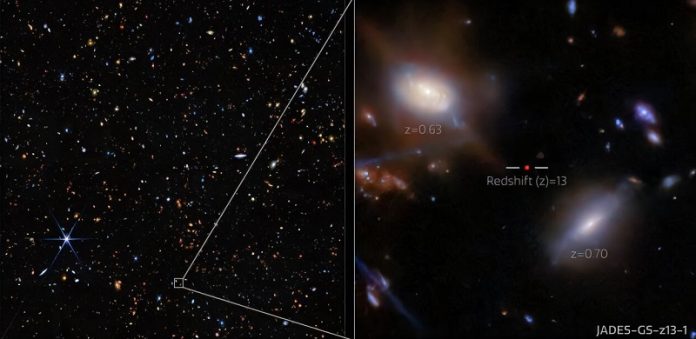
Astronomers using the James Webb Space Telescope have discovered a galaxy that’s making scientists rethink what they know about the early universe.
This galaxy, named JADES-GS-z13-1, is incredibly far away.
In fact, it’s seen as it was just 330 million years after the Big Bang, when the universe was still very young—only about 2% of its current age.
The James Webb Space Telescope, launched by NASA, the European Space Agency (ESA), and the Canadian Space Agency (CSA), was designed to look deep into space and time, all the way back to the “cosmic dawn”—when the first stars and galaxies were forming.
Scientists first spotted this galaxy using Webb’s NIRCam camera, which measures light in the infrared part of the spectrum.
This helped them estimate the galaxy’s redshift—a way to measure how far away a galaxy is, based on how much its light has stretched while traveling through the expanding universe. JADES-GS-z13-1 has a redshift of 13.0, confirming it as one of the oldest and most distant galaxies ever seen.
But what really surprised the astronomers was a very specific, bright signal in the galaxy’s light, called Lyman-α radiation.
This kind of light is given off by hydrogen, and it’s usually blocked by the thick “fog” of neutral hydrogen that filled the early universe. At this point in time—just 330 million years after the Big Bang—scientists thought that fog should still be there, making it impossible for this light to escape and reach us.
“This result was totally unexpected,” said Professor Roberto Maiolino from the University of Cambridge. “We didn’t think light like this could travel through space so early in the universe’s history.”
The early universe was full of neutral hydrogen gas, which blocked ultraviolet light from escaping galaxies—like thick fog blocking car headlights. Only after more stars formed and began to ionize the hydrogen did the fog start to clear.
This process, called reionization, wasn’t thought to be complete until about one billion years after the Big Bang.
So how did Lyman-α light from JADES-GS-z13-1 make it through the fog so early?
One idea is that this galaxy is surrounded by a huge bubble of ionized hydrogen, cleared by a special kind of star. These stars may belong to the first generation of stars, which were likely much hotter, brighter, and more massive than stars we see today. Another possibility is that the galaxy contains an active black hole, giving off powerful energy that helped clear the fog.
Scientists don’t yet know the exact cause of the light, but they are planning more observations to find out.
Whatever the answer is, this strange galaxy is giving us a new look at the early universe—and raising exciting new questions about how the first stars and galaxies were born.
Source: University of Cambridge.



